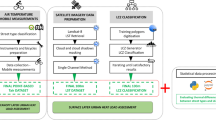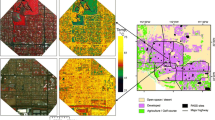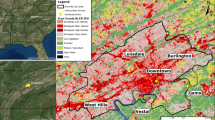Abstract
The public health implications of a warming urban environment mean that appropriate action by planners, designers and health workers will be necessary to minimise risk under future climate scenarios. Data at an appropriate spatial scale are required by user groups in order to identify key areas of vulnerability. Thermal mapping of a UK urban conurbation was carried out during the summers of 2007 and 2008 with the aim of providing high spatial resolution temperature data. The air temperature results showed an average daytime (night time) urban–rural thermal contrast of 3°C (5°C) on summer days (nights) with ideal urban heat island (UHI) conditions. The intensity of the daytime surface temperature heat island was found to exceed 10°C. The measured data were used to derive an empirical model of spatial temperature patterns based upon characteristics of land use, distance from urban centre and building geometry. This model can be used to provide sub-kilometre resolution temperature data which are required by decision makers and can provide a mechanism for downscaling climate model output.
Similar content being viewed by others
References
Best MJ (2005) Representing urban areas within operational numerical weather prediction models. Bound Layer Meteorol 114:91–109
Beswick KM, Gallagher MW, Webb AR, Norton EG, Perry F (2008) Application of the Aventech AIMMS20AQ airborne probe for turbulence measurements during the Convective Storm Initiation Project. Atmos Chem Phys 8:5449–5463
Briggs DJ, Denman AR, Gulliver J, Marley RF, Kennedy CA, Philips PS, Field K, Crockett RM (2003) Time activity modelling of domestic exposures to radon. J Environ Manage 67:107–120
Department of Health (2001) Health effects of climate change in the UK. Department of Health Expert Group on Climate Change and Health in the UK, London
Essery RLH, Best MJ, Betts RA, Cox PM, Taylor CM (2003) Explicit representation of subgrid heterogeneity in a GCM land surface scheme. J Hydrometeorol 4:530–543
Gill SE, Handley JF, Ennos AR, Pauleit S (2007) Adapting cities for climate change: the role of the green infrastructure. Built Environ 33:115–133
Gill SE, Handley JF, Ennos AR, Pauleit S, Theuray N, Lindley SJ (2008) Characterising the urban environment of UK cities and towns: a template for landscape planning in a changing climate. Landsc Urban Plan 87:210–222
Grimmond CSB, Oke TR (1999) Aerodynamic properties of urban areas derived from analysis of surface form. J Appl Meteorol 38:1262–1292
Hulme M, Jenkins GJ, Lu X, Turnpenny JR, Mitchell TD, Jones RG, Lowe J, Murphy JM, Hassell D, Boorman P, McDonald R, Hill S (2002) Climate change scenarios for the United Kingdom: the UKCIP02 scientific report. Tyndall Centre for Climate Change Research, School of Environmental Sciences, University of East Anglia, Norwich
Jenkins G, Perry M, Prior J (2009) The climate of the United Kingdom and recent trends. UKCIP, Oxford
Lader D, Hort S, Gershuny J (2006) The time use survey 2005. Office for National Statistics, London. Available from: http://www.statistics.gov.uk/articles/nojournal/time_use_2005.pdf. Accessed 07/01/2009
Landsberg HE (1981) The urban climate. Academic Press, New York
Larsen J (2006) Setting the record straight: more than 52000 Europeans died from heat in summer 2003. Earth Policy Institute, 2006. http://www.earth-policy.org/Updates/2006/Update56.htm
Levermore G, Chow D, Jones P, Lister D (2004) Accuracy of modelled extremes of temperature and climate change and its implications for the built environment in the UK. Tyndall Centre for Climate Change Research Technical Report 14. http://www.tyndall.ac.uk/research/theme3/final_reports/it1_8.pdf
Lindley SJ, Handley JF, Theuray N, Peet E, McEvoy D (2006) Adaptation strategies for climate change in the urban environment: assessing climate change related risk in UK urban areas. J Risk Res 9:543–568
Mann ME, Schmidt GA (2003) Ground vs. surface air temperature trends: implications for borehole surface temperature reconstructions. Geophys Res Lett 30:1607–1611
Matzarakis A, Mayer H, Iziomon MG (1999) Applications of a universal thermal index: physiological equivalent temperature. Int J Biometeorol 43:76–84
McCarthy MP, Best MJ, Betts RA (2010) Climate change in cities due to global warming and urban effects. Geophys Res Letts 37:L09705
McGeehin MA, Mirabelli M (2001) The potential impacts of climate variability and change on temperature-related morbidity and mortality in the United States. Environ Health Perspect 109:185–189
Meehl GA, Stocker TF, Collins WD, Friedlingstein P, Gaye AT, Gregory JM, Kitoh A, Knutti R, Murphy JM, Noda A, Raper SCB, Watterson IG, Weaver AJ, Zhao Z-C (2007) Global climate projections. In: Solomon S, Qin D, Manning M, Chen Z, Marquis M, Averyt KB, Tignor M, Miller HL (eds) Climate change 2007: the physical science basis. Contribution of working group I to the fourth assessment report of the intergovernmental panel on climate change. Cambridge University Press, Cambridge
Office for National Statistics (2001) Census 2001. http://www.statistics.gov.uk/census2001/census2001.asp
Oke TR (1981) Canyon geometry and the nocturnal urban heat island: comparison of scale model and field observations. J Climatol 1:237–254
Oke TR (1987) Boundary layer climates. Routledge, London
Patz JA, Campbell-Lendrum D, Holloway T, Foley JA (2005) Impact of regional climate change on human health. Nature 438:310–317
Pointer G (2005) Focus on people and migration: the UK’s major urban areas. Office for National Statistics
Smith CL, Lindley SJ, Levermore GJ (2009) Estimating spatial and temporal patterns of urban anthropogenic heat fluxes for UK cities: the case of Manchester. Th. Appl. Climatol
United Nations (2003) World urbanization prospects: the 2003 revision. United Nations, New York
Watkins R, Palmer J, Kolokotroni M, Littelefair P (2002) The London heat island: results from summertime monitoring. Build Serv Eng Res Technol 23:97–106
Wilby RL, Troni J, Biot Y, Tedd L, Hewitson BC, Smith DG, Sutton RT (2009) A review of climate risk information for adaptation and development planning. Int J Clim 29:1193–1215
Willows RI, Connell RK (eds) (2003) Climate adaptation: risk, uncertainty and decision-making. UKCIP technical report. UKCIP, Oxford
Yann W, Mikami T (2002) Temperature observed on the ground. J Geogr 111:695–710
Author information
Authors and Affiliations
Corresponding author
Rights and permissions
About this article
Cite this article
Smith, C.L., Webb, A., Levermore, G.J. et al. Fine-scale spatial temperature patterns across a UK conurbation. Climatic Change 109, 269–286 (2011). https://doi.org/10.1007/s10584-011-0021-0
Received:
Accepted:
Published:
Issue Date:
DOI: https://doi.org/10.1007/s10584-011-0021-0




